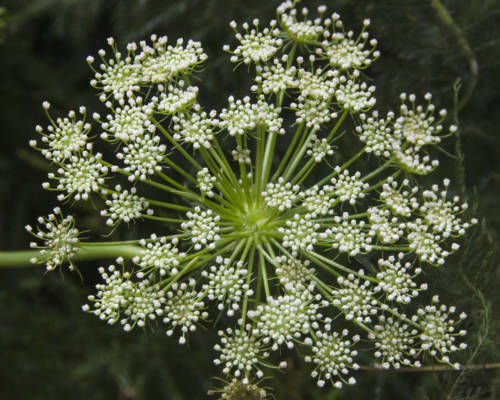
Ask Ella: Why Queen Anne’s Lace Looks Better In Green
Ask Ella is a recurring Garden Collage feature where we ask our in-house florist, EllaStavonsky, about floral design– including the history of, origin, and maintenance that goes into some of the most intriguing flowers on the market today. This column is dedicated exclusively to common and rare varieties of flowers you’re likely to find at your local market. This week, we spotlight Queen Anne’s Lace, a longtime favorite of many a bouquet that gets a fresh take in soft green.
***
Queen Anne’s Lace (Daucus carota), which goes sometimes by the names of bishop’s lace or bird’s nest, is a flower nearly impossible to avoid at any florist’s. Delicate bursts of buds are clustered at the top of the stem in small, tight bundles, giving a firework-like appearance. White is the most common variety you’re likely to see, but pale greens and sharp yellows are frequently available as well. If the flowers look familiar to any avid vegetable gardeners out there, don’t be surprised– Queen Anne’s Lace is actually a botanic grandmother to Daucus carota subsp. sativus, better known simply as carrots. Queen Anne’s Lace is actually the flower of a wild variety of carrot and while wild carrot can be eaten, extreme caution should be taken when foraging, as Queen Anne’s Lace bears a strong resemblance to poison hemlock, which (unhelpfully) also has a carrot-like root and is extremely toxic.
Since Queen Anne’s lace is most commonly found in shades of white, it is sometimes confused for baby’s breath, as both are an inexpensive, unobtrusive filler flower. We like Queen Anne’s Lace best in its light green variety (which, pictured above, looks white upon very close inspection). The green shade also feels a bit more chic, elegant, and fresh than the pure white.
“In its green variety, Queen Anne’s Lace works beautifully with different varieties of greenery, like ferns and jasmine. It feels summery and rich,” Ella explains. Its blossoming shape also helps to fill out any sparse spaces in arrangements and as it is in season all year.
While Queen Anne’s Lace is relatively sturdy plant that can endure even the most absent-minded of caretakers, their life can be prolonged by cutting the stems and placing them in hot water immediately upon arriving home. Thereafter, the stems should be recut half an inch each day, and the vase should be refilled with fresh, hot water.


































